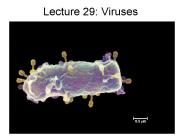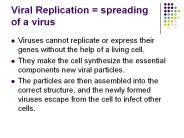Lysogenic PowerPoint PPT Presentations
All Time
Recommended
Prophage may confer new properties upon cell ... Kuru spongiform encephalopathy. Central nervous system. Humans. Mad cow spongiform encephalopathy ...
| PowerPoint PPT presentation | free to view
Questions 5. How does the lysogenic cycle change to the lytic cycle? The lysogenic cycle enters the lytic cycle when a stimulus, usually stress related, triggers the ...
| PowerPoint PPT presentation | free to view
18.1 1. Compare the effect on the host cell of a lytic (virulent) phage and a lysogenic (temperate) phage. Lytic Can only carry out lysis of host cell Lysogenic Can ...
| PowerPoint PPT presentation | free to download
lysogenic cycle, in which the. host cell is not destroyed. 18.2 Viral ... A lysogenic infection does no immediate harm. The viral DNA is called a prophage ...
| PowerPoint PPT presentation | free to download
Lytic pathway Lysogenic pathway Edwards & Rohwer (2005) The proviral metagenome Edwards & Rohwer (2005) Viral community structure and ecology SQ14.
| PowerPoint PPT presentation | free to download
Wake-up Explain briefly the difference between the lytic and lysogenic cycles. List anything you can remember about prokaryotic cells (Bacteria).
| PowerPoint PPT presentation | free to view
Lysogenic. integrate viral DNA into bacterial DNA. reproduce with bacteria. 2005-2006 ... Lysogenic lifecycle of phages. 2005-2006. Defense against viruses ...
| PowerPoint PPT presentation | free to view
Attach, entry, replication, assembly, lysis. Lysogenic Cycle. Attach. Lysogenic Cycle ... of new viruses. Lysogenic Cycle. Lysis and release of new viruses ...
| PowerPoint PPT presentation | free to view
The virus may enter the lysogenic cycle, ... body fluids Chicken Pox respiratory droplets (sneeze) Hepatitis B ... PowerPoint Presentation Author: McDougal Littell
| PowerPoint PPT presentation | free to download
Most viruses are so small, they can only be seen with an electron microscope. Viral Structure ... The lysogenic cycle. Lytic Cycle ... Lysogenic Cycle ...
| PowerPoint PPT presentation | free to view
Viruses and Other Weird Infectious Agents Virus Cycles: Lytic & Lysogenic Viruses hijack the cell machinery HIV is a Retrovirus Reverse Transcriptase uses viral ...
| PowerPoint PPT presentation | free to view
Negative gene control Lac Operon Trp Operon Plasmid Transformation Conjugation Retrovirus Lytic cycle Lysogenic cycle Operon Inducible and repressible Promoter
| PowerPoint PPT presentation | free to download
... eat (greek) Two major types: Lytic and Lysogenic. Different Types of Bacteriophages ... Lysogenic- infect the cell and integrates its genetic material into the ...
| PowerPoint PPT presentation | free to view
CLASSIFICATION, BACTERIA, AND VIRUSES Biology Virus Viral Infections can take place in two ways- Lytic infection Lysogenic infection Virus Lytic Infection The virus ...
| PowerPoint PPT presentation | free to download
Viruses Page 328 * Objectives Describe why viruses are not considered as living organisms. Describe the basic structure of viruses. Compare the lytic and lysogenic ...
| PowerPoint PPT presentation | free to view
lysogenic or temperate phage. Transduction. Bacteriophage or ... Generalized transduction lytic or lysogenic phage. any suitably sized piece of DNA packaged ...
| PowerPoint PPT presentation | free to view
Lysogenic Infection. Host cell makes copies of virus indefinitely. Viral DNA embeds into host DNA ... The Lysogenic Cycle temperate virus ...
| PowerPoint PPT presentation | free to view
... Bacteriophages ? ... Lysogenic phages: For bacteriophage M13, phage particles ... Gene Cloning Bacteriophages M13. Genes can be obtained in ...
| PowerPoint PPT presentation | free to view
Lysogenic Cycle. Viral Genome integrates into host chromosome. Prophage viral DNA ... Lysogenic Cycle: Bacteriophage. Integration. Viral DNA becomes prophage ...
| PowerPoint PPT presentation | free to view
Some viruses may remain dormant inside host cells for long periods, causing no obvious change in their host cells (a stage known as the lysogenic phase).
| PowerPoint PPT presentation | free to view
... different replication cycles of bacteriophages; the lytic cycle and lysogenic cycle. Bacteriophage. Viruses that infect bacteria. Lytic Cycle ...
| PowerPoint PPT presentation | free to view
direct damage in the immediate vicinity. grow & multiply ... scarlet fever/scarlatina. lysogenized bacteriophage codes for toxin. mechanisms of pathogenicity ...
| PowerPoint PPT presentation | free to view
Lysogenic pathway. Viral DNA integrates into bacterial chromosome ... two pathways common in the multiplication of bacteriophages: lytic and lysogenic ...
| PowerPoint PPT presentation | free to view
infection, growth, lysis. lysogenic cycle: temperate phages ... the 'decision' between lysis & lysogeny depends on a competition between two repressors ...
| PowerPoint PPT presentation | free to view
Can Identify Several. Viruses. Replicate by. Host Cell ... Lysogenic. Cycle. Viral DNA. Host Cell's. Chromosome. Provirus. Continue. Replication of host cell ...
| PowerPoint PPT presentation | free to view
Lesson Overview 20.1 Viruses HIV Retroviral infections are similar to lysogenic infections of bacteria. Much like a prophage in a bacterial host, the viral DNA may ...
| PowerPoint PPT presentation | free to view
Virus can have either the lytic or lysogenic life cycle Markham Study of HIV ... progressors My partner and I ... Selection of Subjects, ClustalW ...
| PowerPoint PPT presentation | free to download
Methanogens (convert H2 & CO2 into methane gas), Thermoacidophiles (love acidic, hot ... Lysogenic Cycle. Infect cell but do not cause disease immediately. ...
| PowerPoint PPT presentation | free to view
They have NO characteristics of life. ... Lysogenic Cycle: Virus replication that does not. kill the cell. Virus Invading a Cell ...
| PowerPoint PPT presentation | free to view
... bacteriophage gal bio gal bio gal bio gal bio bio gal specialized transduction lysogenic conversion DNA recombination protoplast fusion The Ames Test for ...
| PowerPoint PPT presentation | free to view
from Thomas, R. and Kaufman, M. 'Conceptual tools for the ... flower formation; T helper cells; lytic vs. lysogenic choice in bacteriophage; embryogenesis ...
| PowerPoint PPT presentation | free to view
Most of the gene products of the lysogenic phage remains dormant until it is ... http://justice.loyola.edu/~klc/BL472/GAS/ http://www.med.sc.edu:85/mayer/phage.htm ...
| PowerPoint PPT presentation | free to view
... (lytic infection) infected bacterium bursts (lyses) releasing its progeny. ... Lysis means that the cell wall, and/or plasma membrane are damaged. lysogenic phase ...
| PowerPoint PPT presentation | free to view
Life cycle of phage ?. Adsorption. Lysogenic response. Cell division. Induction. Lytic response. Cell lysis and release of mature phages ...
| PowerPoint PPT presentation | free to view
Ebola Virus. Common Cold Virus. Measles. Polio. Hepatitis B. Bacteriophage ... Lytic and Lysogenic Cycles of the Bacteriophage Virus. Viral Replication. Vaccine ...
| PowerPoint PPT presentation | free to view
Considered to be the founder of modern evolutionary theory ... The Lysogenic Cycle. Virus Reproduction. The Lytic Cycle. Lytic Cycle ...
| PowerPoint PPT presentation | free to view
Lecture 29: Viruses 0.5 m Lecture outline 11/11/05 Types of viruses Bacteriophage Lytic and lysogenic life cycles DNA viruses RNA viruses Influenza HIV Prions Mad cow ...
| PowerPoint PPT presentation | free to download
Disease can be caused by prokaryotes, viruses, fungi, protists, worms, insects, ... (2) A Lysogenic Life style. 9. Viral Multiplication/Lifecycle. 10. Gene Therapy ...
| PowerPoint PPT presentation | free to view
The Genetics of Bacteria and Their ... Those phages that are also capable of the lysogenic cycle are called temperate General Transduction A bacterial virus, ...
| PowerPoint PPT presentation | free to download
Viruses ARE segments of nucleic acid (DNA or RNA) wrapped in a protein coat ... Lysogenic Cycle. 1. Virus attaches to a cell and injects its DNA ...
| PowerPoint PPT presentation | free to view
Bacteriophages ( phages ) are obligate intracellular parasites that ... Contractile Sheath. Capsid. DNA. Types of Bacteriophage. Lytic or Virulent Phages. ????? ...
| PowerPoint PPT presentation | free to view
HAPPY FRIDAY Bellwork Bellwork: Draw and Label the viruses above using the following terms: Capsid, DNA/RNA, Envelope. THEN Bring up your bellwork so I can sign it.
| PowerPoint PPT presentation | free to view
KEY CONCEPT Viruses exist in a variety of shapes and sizes. Viruses differ in shape and in ways of entering host cells. Viruses have a simple structure.
| PowerPoint PPT presentation | free to view
Viral Replication = spreading of a virus Viruses cannot replicate or express their genes without the help of a living cell. They make the cell synthesize the ...
| PowerPoint PPT presentation | free to download
The Virus What is a Virus? Virus Latin for Poison Non-cellular particle with DNA or RNA 1 or 2 Protein Coats (Capsids) May have Viral Envelope - Phospholipids DO NOT ...
| PowerPoint PPT presentation | free to download
Tobacco Mosaic Virus Enteroviruses cause many common illnesses such as polio, ... The virus destroys the host DNA and uses the cell s materials to create new ...
| PowerPoint PPT presentation | free to view
http://www.cellsalive.com/howbig.htm
| PowerPoint PPT presentation | free to view
http://www.cellsalive.com/howbig.htm Why haven t phages exterminated all bacteria? Restriction Enzymes in bacteria Methylation of bacterial DNA prevents the ...
| PowerPoint PPT presentation | free to view
Ch. 19 Warm-up Why do many scientists classify viruses as non-living? Draw the basic structure of a virus. Label and define capsid, viral envelope and nucleic acid.
| PowerPoint PPT presentation | free to view
Lesson Overview 20.1 Viruses
| PowerPoint PPT presentation | free to download
VIRUSES What is a virus? A virus is a submicroscopic infectious particle composed of a protein coat ( ) and a nucleic acid core ( ) Viruses are similar in ...
| PowerPoint PPT presentation | free to view
VIRUS Notes Definition Viruses are tiny particles unlike any other organism. A virus consists of genetic material such as RNA or DNA wrapped in a protein coat.
| PowerPoint PPT presentation | free to view
VIRUS Notes Definition Viruses are tiny particles unlike any other organism. A virus consists of genetic material such as RNA or DNA wrapped in a protein coat.
| PowerPoint PPT presentation | free to download
Viral History Discovery of Viruses Beijerinck ... A virus is a non-cellular particle made up of genetic material and protein that can invade living cells.
| PowerPoint PPT presentation | free to download
Biology 102A ... viruses
| PowerPoint PPT presentation | free to view
























































